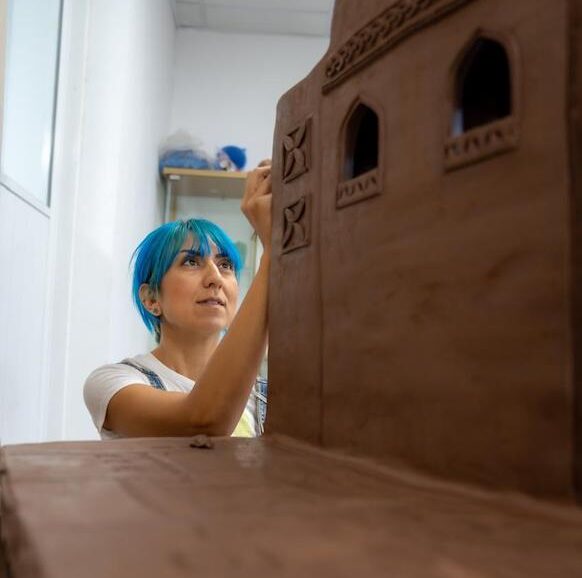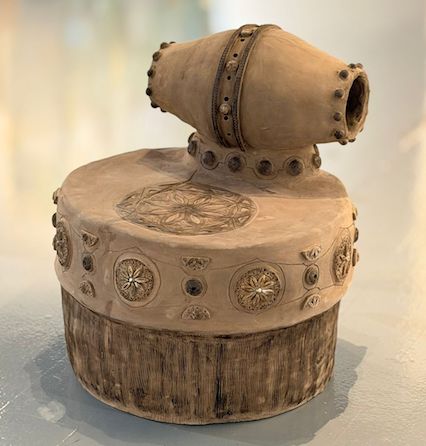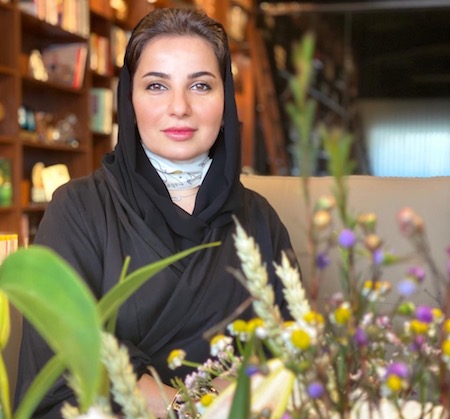 By HUBERT VAZ
By HUBERT VAZ
Ceramic artist Shima Amia’s upcoming exhibition at Alia Gallery, Rusayl, (opening October 20) explores a dialogue between tradition and modern living. ‘Rooted in the richness of Omani culture, the works reimagine ceramic art as functional forms — sculptural clay seats that carry the memory of heritage while becoming part of daily life,’ says Shima
When you visit a solo exhibition presented by Shima Amia, be prepared to return with a good measure of ‘food for thought’ as every show put up by this talented ceramic artist often leaves the viewer overcome by a strange sense of euphoria that transcends time and space…
In an upcoming exhibition – Living Tradition – to be held at Alia Gallery from Monday, Shima offers a new look at tradition and culture, breathing new life into the past, merging beauty, utility, and identity through clay, the elemental material of the earth.
This exhibition marks her first collection, where heritage becomes the foundation for a new language of design, says Shima, who believes that ‘art is not confined to walls or galleries, it is meant to be lived with, touched, and used’. Each piece invites people not only to witness Omani culture but to sit within it — to experience heritage as a living, evolving presence in modern spaces.
The exhibition also includes a collaboration between Shima Amia and Alia al Farsi, whose selected works have been reimagined into sculptural clay seats. Together, these creations embody a vision where culture is not only preserved but transformed into a new form of functional art.
In a free-wheeling chat with Muscat Daily, Shima shares the inspiration that works within herself. Excerpts:
Who conceived this exhibition – what was the motive behind it?
The concept of this exhibition began with me. I have been developing the idea of Functional Art and Furniture since 2023, and one of the first pieces I created two years ago is also part of this show. Later, I shared the idea with Alia, and she immediately connected with it. I suggested that we could bring her paintings into a new dimension — transforming her imagery into functional sculptural pieces, like a chair inspired by her work. The main motive was to merge our two creative worlds and celebrate Omani culture through both form and emotion — turning art into something that can be experienced, touched, and lived with.
There have been numerous shows based on Oman’s cultural heritage, how different will this exhibition be?
This exhibition goes beyond representation — it transforms culture into experience. My pieces are not just inspired by heritage, they embody it through material and form. Each work is functional, made from clay, merging design and art to show how tradition can evolve into contemporary living while keeping its soul intact.
How exactly do you explore the dialogue between tradition and modern living?
For me, tradition and modernity are not opposites — they coexist. I use traditional Omani references, such as jewellery forms, door motifs, or forehead ornaments, but reinterpret them in minimalist, sculptural ways. Clay becomes a bridge between past and present — a timeless, natural medium reshaped with modern design sensibility.
Do you think the roots of Omani traditions still have a bearing on modern life in Oman?

Absolutely. Omani traditions still define our collective sense of beauty, identity, and values. Even as lifestyles change, the aesthetic and spiritual essence of our heritage continues to influence how we connect to space, design, and one another. My work is an attempt to make that connection tangible again.
Have you brought about any glaring contrasts about life in Oman through this exhibition?
Yes — the contrast between what is fading and what remains. Through the pieces, I wanted to highlight how deeply cultural symbols are embedded in us, even when they no longer appear in our daily surroundings. The contrast is subtle yet powerful — tradition reshaped, not replaced.
What is your own opinion about current multi-dimensional artworks? Will they eventually replace 2D canvases?
I believe multi-dimensional art expands rather than replaces. Each medium has its own voice. 3D and functional artworks invite the audience to touch, move, and experience — they create a dialogue. But painting remains timeless. The future lies in coexistence, not competition, between mediums.
What is your key source of inspiration and does it always dictate your body of work?
My inspiration comes from Omani culture and the feminine energy — the body, movement, and everyday rituals. I start with a clear vision, but clay always leads me somewhere unexpected. I welcome that transformation. The material has its own rhythm, and I let intuition guide the process.
How well do your works gel with those of Alia’s in this collection?
Our works create a dialogue between the spiritual and the tangible. Alia’s paintings reflect emotion, memory, and symbolism, while mine transform those ideas into physical, functional forms. Together, they form a unified story — a conversation between soul and structure, between memory and modernity.
Do you think visually challenged persons will be able to experience this show in some way?
Yes, definitely. My pieces are tactile by nature — they invite touch. The textures of clay, the curves, and forms can be felt and understood through the hands. It’s an inclusive experience that goes beyond sight, allowing people to connect through sense and emotion.
Careerwise, will this show add any new dimension to your repertoire?
Yes, this exhibition marks an important turning point for me. It’s the first time my functional clay works are presented as part of a conceptual dialogue with painting. It opens a new path where design, craft, and art merge — strengthening my vision of building a movement of culturally rooted functional art from Oman.
‘Shima’s sculpures convey strength’

Shima Amia and I are drawn to exploring human experiences and emotions through our work. Her sculptures and my pieces share a narrative quality they communicate stories of resilience, identity, and transformation. In this collaboration, her nine sculptures three of which are inspired by my artworks create a meaningful dialogue between our visions.
I believe art is meant to be immersive. Moving beyond the wall allows viewers to experience the work from all angles and engage with it in a more physical and emotional way. This approach encourages interaction and reflection, creating a fuller connection between the audience and the art.
I admire Shima’s meticulous attention to detail and the strength her sculptures convey. While her work has a precise, thoughtful quality, I don’t think it’s purely intellectual there’s a depth of emotion and sensitivity that comes through, balancing mind and heart beautifully.
The collaboration demonstrates how artists can inspire one another and expand creative boundaries. It shows the importance of experimentation, blending different styles, and taking risks – all lessons that budding artists can apply to their own practice.
Shima Amia’s work is remarkable for its precision, clarity, and emotional depth qualities that make her sculptures truly compelling. Every artist is on a journey of growth, and I believe, she will continue to explore new ideas and dimensions in her work, which will only enrich her already impressive practice.
Alia al Farsi
© 2021 Apex Press and Publishing. All Rights Reserved. Powered by Mesdac